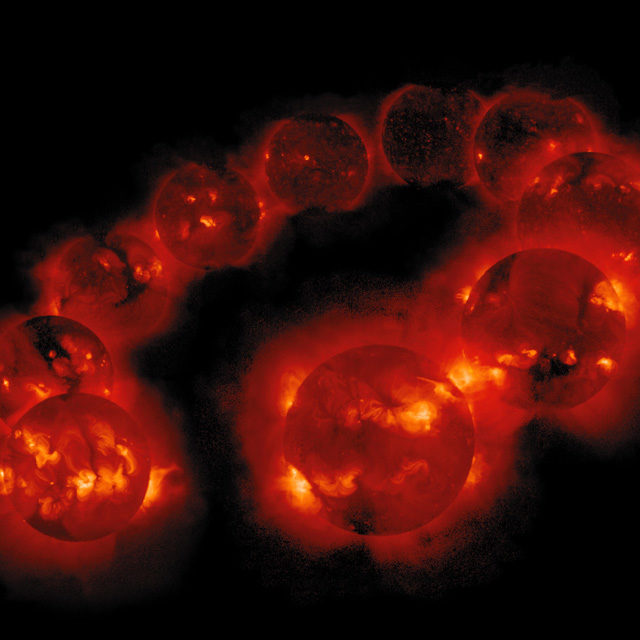
In 1966, astronomer Olin Wilson started what would become a decades-long pursuit, searching for an answer to a simple question. Wilson knew that observations of sunspots spanning more than 200 years had revealed a remarkable order, a magnetic heartbeat that appeared to pulse every 11 years. He wondered whether other stars would show similar heartbeats, so he began collecting regular measurements to find out. More than 50 years later, the complete archive of Wilson’s data has found its way to Boulder, sparking renewed interest in the magnetic evolution of stars like the sun, and a possible connection to the development of complex life.
When Galileo projected the light of the sun through his telescope in 1610, he noticed dark spots on the surface. Astronomers eventually discovered that these sunspots were strongly magnetic, inhibiting the flow of heat from the interior and creating a cool patch that appears darker than its surroundings. Two centuries later, German astronomer Samuel Schwabe conducted regular observations of the sun for many years and made a startling discovery. The number of visible sunspots appeared to change over time, increasing and decreasing in a regular pattern that repeated, on average, every 11 years. Modern observations have revealed both the rich complexity and the underlying order of this pattern, showing modest fluctuations around a steady rhythm.
Olin Wilson’s experiment took advantage of a fingerprint of stellar magnetism that is revealed when passing the light of a star through a prism to produce the full spectrum of its intensities. At the blue end of the spectrum, a feature caused by calcium was sensitive to the strength of a magnetic field. Patient observations of this feature on the sun clearly showed its 11-year heartbeat, so Wilson decided to monitor the same feature on other stars. Using the 100-inch telescope at Mount Wilson Observatory in California, he made monthly measurements of nearly 100 stars for more than a decade. What he found was tantalizing: Many of the stars showed variations like the sun, but there were also differences that would require more observation to understand. The Mount Wilson survey, as it is now known, finally ended in 2003 after nearly 40 years of unprecedented measurements.
“Ideally in science you would like to run experiments, to change the conditions and see how the object under study responds,” says Ricky Egeland, a postdoctoral fellow in the Advanced Study Program at the National Center for Atmospheric Research (NCAR). “The sun can be thought of as one experiment, but the stars give us many more.”
Egeland is originally from Minnesota, where he studied physics and started working with an international team developing software for a large particle physics experiment at the European Center for Nuclear Research (CERN) in Switzerland. After graduating in 2003, he took a job at CERN as a database software developer, but his passion for physics prompted him to return to the U.S. in 2011 to enroll in a Ph.D. program at Montana State University. In 2014, a graduate research fellowship at NCAR brought him to Boulder to work with the experts in solar physics at the High Altitude Observatory. He defended his Ph.D. thesis in 2017, and since then has continued working at NCAR to understand what the magnetic heartbeats in other stars can teach us about our own sun.
At the beginning of his doctoral research, Egeland contacted the astronomers who were responsible for the Mount Wilson survey, hoping to gain access to the complete data set. He started by asking for one star, which he quickly analyzed and combined with more recent observations to make a new discovery. His second request was for the two dozen stars that most resembled the sun, which became the central sample of his thesis. He used the old data to make significant new discoveries, gaining the confidence of the Mount Wilson team and demonstrating that their survey data contained a lot of unexploited value. While attending a science conference in Boston last summer, Egeland met with his contact from the Mount Wilson team and explained why he wanted to curate the complete archive of observations and make them more broadly available.
“The data were acquired in an earlier age, when things like open data policies were not technically feasible, let alone standard practice,” Egeland says. “We agreed to work toward publicly releasing the full archive, but doing so in a well-organized way that documents the technical details and the history of this unique data set.”
The full archive of Mount Wilson data is now in Boulder, and Egeland is working to incorporate it into a public database with observations of the sun and stars that he established during his doctoral work. The smaller sample that he analyzed during his thesis suggested that stars like the sun may show a dramatic shift in their magnetic heartbeats around the middle of their lifetimes. From the best information currently available, our sun appears to have entered this relatively stable phase a few hundred million years ago, just as life was emerging from the oceans onto land.
It might just be a coincidence, but the discovery suggests that more mature stars may be the best places to search for technological civilizations. Younger stars bombard their planets with radiation and charged particles that are hostile to the development of complex life, but older stars appear to quiet down and provide a more stable environment. The release of the complete Mount Wilson survey data in the coming years will facilitate a more thorough examination of these fascinating ideas.
Travis Metcalfe, Ph.D., is a researcher and science communicator based in Boulder. The Lab Notes series is made possible in part by a research grant from the National Science Foundation.














